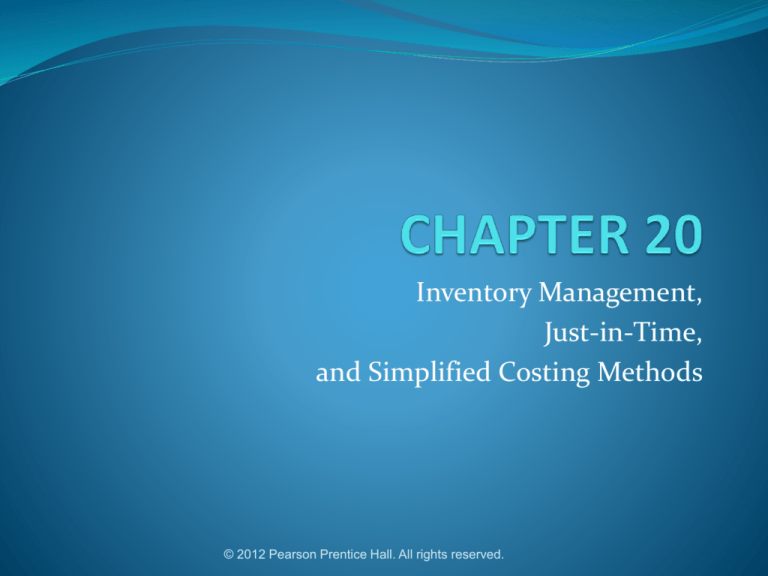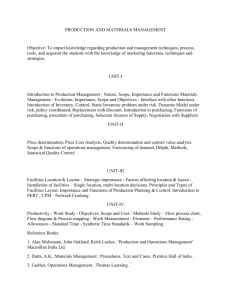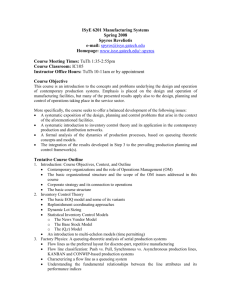
Inventory Management,
Just-in-Time,
and Simplified Costing Methods
© 2012 Pearson Prentice Hall. All rights reserved.
Inventory Management in
Retail Organizations
Inventory management is planning, coordinating, and
controlling activities related to the flow of inventory
into, through, and out of an organization.
© 2012 Pearson Prentice Hall. All rights reserved.
Costs Associated with
Goods for Sale
Managing inventories to increase net income
requires effectively managing costs that fall into
these six categories:
Purchasing costs
2. Ordering costs
3. Carrying costs
4. Stockout costs
5. Quality costs
6. Shrinkage costs
1.
© 2012 Pearson Prentice Hall. All rights reserved.
Management of Inventory Costs
1.
2.
Purchasing costs—the cost of goods acquired from
suppliers, including freight
Ordering costs—the costs of preparing and issuing
purchase orders, receiving and inspecting the items
included in the orders, and matching invoices
received, purchase orders, and delivery records to
make payments
© 2012 Pearson Prentice Hall. All rights reserved.
Management of Inventory Costs
Carrying costs—the costs that arise while holding
inventory of goods for sale. This includes the
opportunity cost of the investment tied up in
inventory, and costs associated with storage.
4. Stockout costs—the costs that result when a
company runs out of a particular item for which
there is customer demand (stockout) and the
company must act quickly to meet the demand or
suffer the costs of not meeting it.
3.
© 2012 Pearson Prentice Hall. All rights reserved.
Management of Inventory Costs
5.
Quality costs—the costs that result when features
and characteristics of a product or service are not in
conformance with customer specifications. These
costs include:
Prevention
2. Appraisal
3. Internal failure
4. External failure
1.
6.
Shrinkage costs—costs that result from theft,
embezzlement, and clerical errors
© 2012 Pearson Prentice Hall. All rights reserved.
The First Step in Managing
Goods for Sale
The first decision in managing goods for sale is how
much to order of a given product.
Economic order quality (EOQ) is a decision model that
calculates the optimal quantity of inventory to order
under a given set of assumptions.
© 2012 Pearson Prentice Hall. All rights reserved.
Basic EOQ Assumptions
There are only ordering and carrying costs.
The same quantity is ordered at each reorder point.
Demand, purchase-order lead time, ordering costs,
and carrying costs are known with certainty.
Purchasing costs per unit are unaffected by the
quantity ordered.
No stockouts occur.
EOQ ignores purchasing costs, stockout costs, and
quality costs.
© 2012 Pearson Prentice Hall. All rights reserved.
Total costs of ordering and carrying
Total Relevant Costs = Ordering Costs + Carrying
Costs
TRC = (D/Q)*P + (Q/2)*C
D = Demand in units for the time period
Q = Quantity ordered each time
P = Relevant ordering costs per order
C = Relevant carrying costs for one unit, one period
© 2012 Pearson Prentice Hall. All rights reserved.
Ordering and Carrying Costs
Illustrated
© 2012 Pearson Prentice Hall. All rights reserved.
EOQ Formula (to minimize TRC)
EOQ =
√
2DP
C
D = Demand in units for specified period
P = Relevant ordering costs per purchase order
C = Relevant carrying costs of one unit in stock for
the time period used for D
(c) 2012 Pearson Prentice Hall. All rights reserved.
Ordering Points
The second decision in managing goods for sale is
when to order a given product.
Reorder point—the quantity level of inventory on
hand that triggers a new purchase order.
Reorder
Point
=
Number of units sold
per unit of time
X
© 2012 Pearson Prentice Hall. All rights reserved.
Purchase Order
Lead Time
Ordering Points Illustrated
© 2012 Pearson Prentice Hall. All rights reserved.
Inventory Management and
Safety Stock
Safety stock is inventory held at all times regardless of
the quantity of inventory ordered using the EOQ
model.
Safety stock is a buffer against unexpected increases in
demand, uncertainty about lead time, and unavailability
of stock from suppliers.
© 2012 Pearson Prentice Hall. All rights reserved.
Safety Stock Computation Illustration
© 2012 Pearson Prentice Hall. All rights reserved.
Estimating Inventory-Related Relevant Costs
Carrying costs
Stockout costs
Ordering costs
© 2012 Pearson Prentice Hall. All rights reserved.
Carrying Costs
Relevant inventory carrying costs consist of relevant
incremental costs and the relevant opportunity cost of
capital.
Relevant incremental costs—those costs of the
purchasing firm that change with the quantity of
inventory held.
© 2012 Pearson Prentice Hall. All rights reserved.
Opportunity Costs
Relevant opportunity cost of capital—the return
foregone by investing capital in inventory rather than
elsewhere.
This cost equals the required rate of return multiplied
by the dollars tied up in inventory
© 2012 Pearson Prentice Hall. All rights reserved.
Cost of a Prediction Error
Three steps in determining the cost of a prediction
error --EOQ example:
Compute the monetary outcome from the optimal
choice, given the actual cost, demand, etc.,
parameters.
1.
P. 709: Order 707 at a time; RTC = $3677
Compute the monetary outcome from the best action
based on the incorrect estimate.
2.
RTC = $3900
Compute the difference between steps 1 and 2.
3.
$3900-$3677 = $223, the additional cost incurred because of
the “error” in forecasting P (purchasing costs).
© 2012 Pearson Prentice Hall. All rights reserved.
Just-in-Time Purchasing
Just-in-time (JIT) purchasing is the purchase of
materials or goods so they are delivered just as needed
for production or sales.
JIT is popular because carrying costs are actually much
greater than estimated because warehousing, handing,
shrinkage, and investment costs have not been
correctly estimated.
© 2012 Pearson Prentice Hall. All rights reserved.
JIT Purchasing
JIT reduces the cost of placing a purchase order
because:
Long-term purchasing agreements define price and
quality terms. Individual purchase orders covered by
those agreements require no additional negotiation
regarding price or quality.
Companies are using electronic links to place purchase
orders at a small fraction of traditional methods (phone
or mail).
Companies are using purchase-order cards.
© 2012 Pearson Prentice Hall. All rights reserved.
Relevant Costs in JIT Purchasing
Purchasing costs
Stockout costs
Quality costs
© 2012 Pearson Prentice Hall. All rights reserved.
Analysis of Alternative Purchasing
Policies Illustrated
© 2012 Pearson Prentice Hall. All rights reserved.
JIT Purchasing and
Supply-Chain Analysis
Supply chain describes the flow of goods, services,
and information from the initial sources of materials
and services to the delivery of products to
consumers (both inside and outside the firm).
Supply chain members share information and
plan/coordinate activities.
Supplier evaluations are critical to JIT purchasing
implementation.
© 2012 Pearson Prentice Hall. All rights reserved.
Supplier Evaluation Illustrated
© 2012 Pearson Prentice Hall. All rights reserved.
EOQ model reconciled with JIT (CB’s addendum)
Revised total.
Recognize that
carrying costs are
higher than thought.
Use modern practices to
reduce ordering costs.
EOQ moves
lower
© 2012 Pearson Prentice Hall. All rights reserved.
Inventory Management and Materials
Requirements Planning
Materials requirements planning (MRP)—a “push-
through” system that manufactures finished goods for
inventory on the basis of demand forecasts
We are not covering in any depth. Not responsible. CB
© 2012 Pearson Prentice Hall. All rights reserved.
Inventory Management and
JIT Production
JIT (lean) production is a “demand-pull”
manufacturing system that manufactures each
component in a production line as soon as and only
when needed by the next step in the production line.
Demand triggers each step of the production
process, starting with customer demand for a
finished product and working backward.
Demand pulls an order through the production line.
© 2012 Pearson Prentice Hall. All rights reserved.
JIT Production Goals
JIT production systems produces close coordination
among work-stations
Smoothes the flow of goods
Achieves low quantities of inventory
JIT aims to simultaneously:
Meet customer demand in a timely manner
Produce high quality products
Generate the lowest possible costs
© 2012 Pearson Prentice Hall. All rights reserved.
JIT Production Features
Production is organized in manufacturing cells, a
grouping of all the different types of equipment used
to make a given product.
Workers are hired and trained to be multi-skilled
(cross-trained).
Defects are aggressively eliminated.
Setup time is reduced.
Suppliers are selected on the basis of their ability to
deliver quality materials in a timely manner.
© 2012 Pearson Prentice Hall. All rights reserved.
Other Benefits of JIT Production
Lower overhead costs
Lower inventory levels
Heightened emphasis on improving quality by
eliminating the specific causes of rework, scrap, and
waste
Lower manufacturing lead times
© 2012 Pearson Prentice Hall. All rights reserved.
Performance Measures and
Control in JIT
Financial performance measures such as inventory
turnover ratio
Nonfinancial performance measures of time,
inventory, and quality such as:
Manufacturing lead times
Units produced per hour
Days of inventory on hand
Setup time as a percentage of total manufacturing time
Number of defective units as a percentage of total units
produced
© 2012 Pearson Prentice Hall. All rights reserved.
Backflush Costing
Backflush costing omits recording some or all of the
journal entries relating to the stages from the
purchase of direct materials to the sale of finished
goods.
Because some stages are omitted, the journal entries for a
subsequent stage use normal or standard costs to work
backward to “flush out” the costs in the cycle for which
journal entries were not made.
We are not covering in detail; not responsible.
© 2012 Pearson Prentice Hall. All rights reserved.








